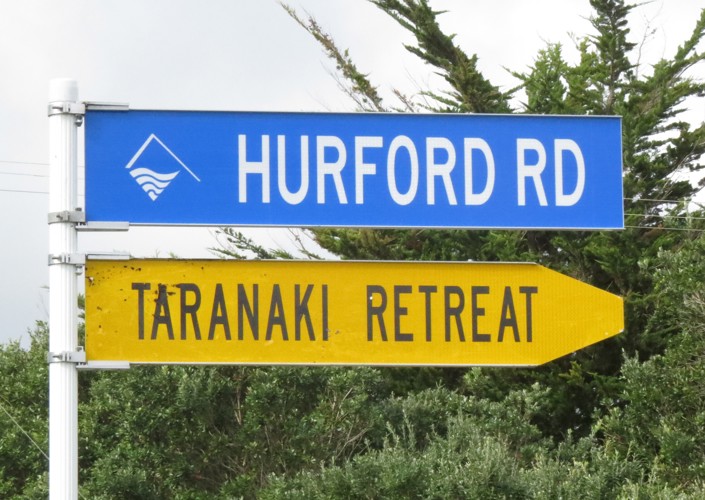 Hurford Road sign (2020). Rachel Sonius. Word on the street image collection.
Hurford Road sign (2020). Rachel Sonius. Word on the street image collection.
 Hurford Road sign (2020). Rachel Sonius. Word on the street image collection.
Hurford Road sign (2020). Rachel Sonius. Word on the street image collection.
Hurford Road was named for a family of Ōmata settlers in the 1850s.
John Hurford and his wife Ann arrived in New Plymouth on the Blenheim in 1842, with their baby daughter who was born in Wellington Harbour as the ship made its way to Taranaki.
The young family thrived in their new home. More children were born and John sold fresh butter every Saturday at the local market. Keen to acquire a bigger farm, the Hurfords purchased a fifty-acre section of bush in Ōmata around 1854. They were obviously well-known in the area, the road to their property being dubbed “the Hurford road” almost immediately. John got involved in local politics and – as tensions rose between Māori and colonists over land sales – made himself available for military service.
When war broke out in March 1860, local Pākehā men gathered in Ōmata stockade while women like Ann took their children and fled to New Plymouth. With thousands of frightened settlers and soldiers crammed into a small area, living conditions in the town deteriorated and disease was rife. The following month Ann and seven of her children were shipped to Nelson on the Airedale, along with hundreds of other “refugees”.
As winter dragged on, fighting left the countryside ravaged and the economy in ruins. Food was scarce so on the night of 2 August John left the safety of the stockade and he and three artillerymen travelled to the Hurford farm to try and find a pig and some potatoes to take back. They were ambushed by what is believed to have been a party of Waikato warriors and John was shot dead. One of the soldiers was also killed, but the others two survived so the bodies were recovered for burial. The Taranaki Herald mourned the loss of “our comrade” but the rest of the Hurford family were also lost, with Ann and her children deciding to remain in Nelson after the war.
John Hurford’s name appears on a memorial stone at St Mary’s Cathedral but he is buried in Ōmata on what was the site of the little Methodist chapel where his family once prayed.
This story was originally published in the Taranaki Daily News.
Please do not reproduce these images without permission from Puke Ariki.
Contact us for more information or you can order images online here.